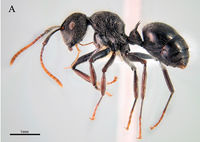Polyrhachis longiseta
| Polyrhachis longiseta | |
|---|---|

| |
| Scientific classification | |
| Kingdom: | Animalia |
| Phylum: | Arthropoda |
| Class: | Insecta |
| Order: | Hymenoptera |
| Family: | Formicidae |
| Subfamily: | Formicinae |
| Tribe: | Camponotini |
| Genus: | Polyrhachis |
| Subgenus: | Myrma |
| Species group: | revoili |
| Species: | P. longiseta |
| Binomial name | |
| Polyrhachis longiseta Rigato, 2016 | |
One of the types was collected from primary forest in a fogging sample.
Identification
Rigato (2016) - A small species in the revoili-group with evenly convex anterior clypeal margin, reduced pronotal teeth, unarmed propodeum, and abundant long standing hairs on body and appendages.
Polyrhachis longiseta comes from the same locality as Polyrhachis dubia and these species look very similar; the relative length of standing hairs is a good feature to separate them. In P. longiseta the longest hairs on tibiae clearly exceed the maximum tibial width and this feature distinguishes it from P. dubia and other species in the revoili-group with a convex anterior clypeal margin and immarginate mesosoma, i.e. Polyrhachis lanuginosa, Polyrhachis revoili and Polyrhachis weissi. All of these are also more strongly sculptured than longiseta.
Keys including this Species
Distribution
Latitudinal Distribution Pattern
Latitudinal Range: -2.30921° to -2.30921°.
| North Temperate |
North Subtropical |
Tropical | South Subtropical |
South Temperate |
- Source: AntMaps
Distribution based on Regional Taxon Lists
Afrotropical Region: Cameroun (type locality), Congo.
Distribution based on AntMaps
Distribution based on AntWeb specimens
Check data from AntWeb
Countries Occupied
| Number of countries occupied by this species based on AntWiki Regional Taxon Lists. In general, fewer countries occupied indicates a narrower range, while more countries indicates a more widespread species. |

|
Estimated Abundance
| Relative abundance based on number of AntMaps records per species (this species within the purple bar). Fewer records (to the left) indicates a less abundant/encountered species while more records (to the right) indicates more abundant/encountered species. |

|
Biology
Castes
Nomenclature
The following information is derived from Barry Bolton's Online Catalogue of the Ants of the World.
- longiseta. Polyrhachis longiseta Rigato, 2016: 28, figs. 8a-c (w.) CAMEROUN.
Unless otherwise noted the text for the remainder of this section is reported from the publication that includes the original description.
Description
Worker
Holotype. HL 1.22, HW 1.02, CI 84, SL 1.44, SI 141, FW 0.37, FI 36, PW 0.74, WL 1.51, HTL 1.20.
Clypeus medially weakly carinate and with its anterior margin evenly convex. Head in full face view oval, with anteriorly converging sides and convex posterior margin. Eyes moderately developed and convex. Mesosoma stout, fully immarginate, evenly convex in profile. Pronotal teeth minute, their anterior edge perpendicular to the longitudinal body axis. Propodeal dorsum and declivity in profile meeting at a blunt obtuse angle, without teeth or ridges. Promesonotal suture clearly visible, metanotal suture faint. Petiole with a dorsal pair of moderately long, slightly diverging spines and a lateral pair of small teeth; the space between dorsal spines evenly and shallowly concave. First gastral tergite anteriorly weakly concave.
Mandibles smooth and shining with sparse piligerous pits. Head, mesosoma and petiole mostly irregularly reticulate-punctate. Head, except clypeus, with a superimposed mostly longitudinal rugosity. Mesosomal dorsum mostly finely longitudinally rugulose. Appendages finely reticulate-punctate. Head, mesosoma and appendages moderately shining. Gaster superficially reticulate and shining.
Standing hairs of uneven length, pale, flexuous and abundant on body and appendages. Longest hairs on tibiae exceed the maximum tibial width; longest hairs on scapes are four times as long as the scape diameter at midlength, or even longer. Pubescence whitish, moderately long and dense on most body surfaces.
Body black, mandibles, legs and scapes mostly piceous, mandibles apically ferrugineous. Funiculus almost entirely testaceous, except its proximally darkened basalmost joints.
Paratype. HL 1.19, HW 0.95, CI 80, SL 1.30, SI 137, FW 0.38, FI 40, PW 0.73, WL 1.42, HTL 1.15. A single worker from the Rep. of the Congo shares all main feature with the holotype.
Type Material
Holotype. CAMEROUN: Mbalmayo, xi.1993 (N. Stork) (The Natural History Museum, specimen tagged “B.Mec, 1 (2)”). Paratype. REP. of the CONGO: Niari Region, 2.30921 S 12.82224 E, 754 m, 4.vii.2013–9.vii.2013, primary forest, canopy fogging (L. Niemand) (1 w, Afribugs Collection: LN-RC1-045, CASENT0250168).
References
- Lenoir, A., P. D’Ettorre, P., Errard, C., Hefetz, A. 2001. Chemical ecology and social parasitism in ants. Annual Review of Entomology 46: 573–599.
- Rigato, F. 2016. The ant genus Polyrhachis F. Smith in sub-Saharan Africa, with descriptions of ten new species. (Hymenoptera: Formicidae). Zootaxa. 4088:1–50.
References based on Global Ant Biodiversity Informatics
- Rigato F. 2016. The ant genus Polyrhachis F. Smith in sub-Saharan Africa, with descriptions of ten new species. (Hymenoptera: Formicidae). Zootaxa 4088: 1-50.

